Competitor Audit Guide: Benchmarking yourself against your brand's competitors
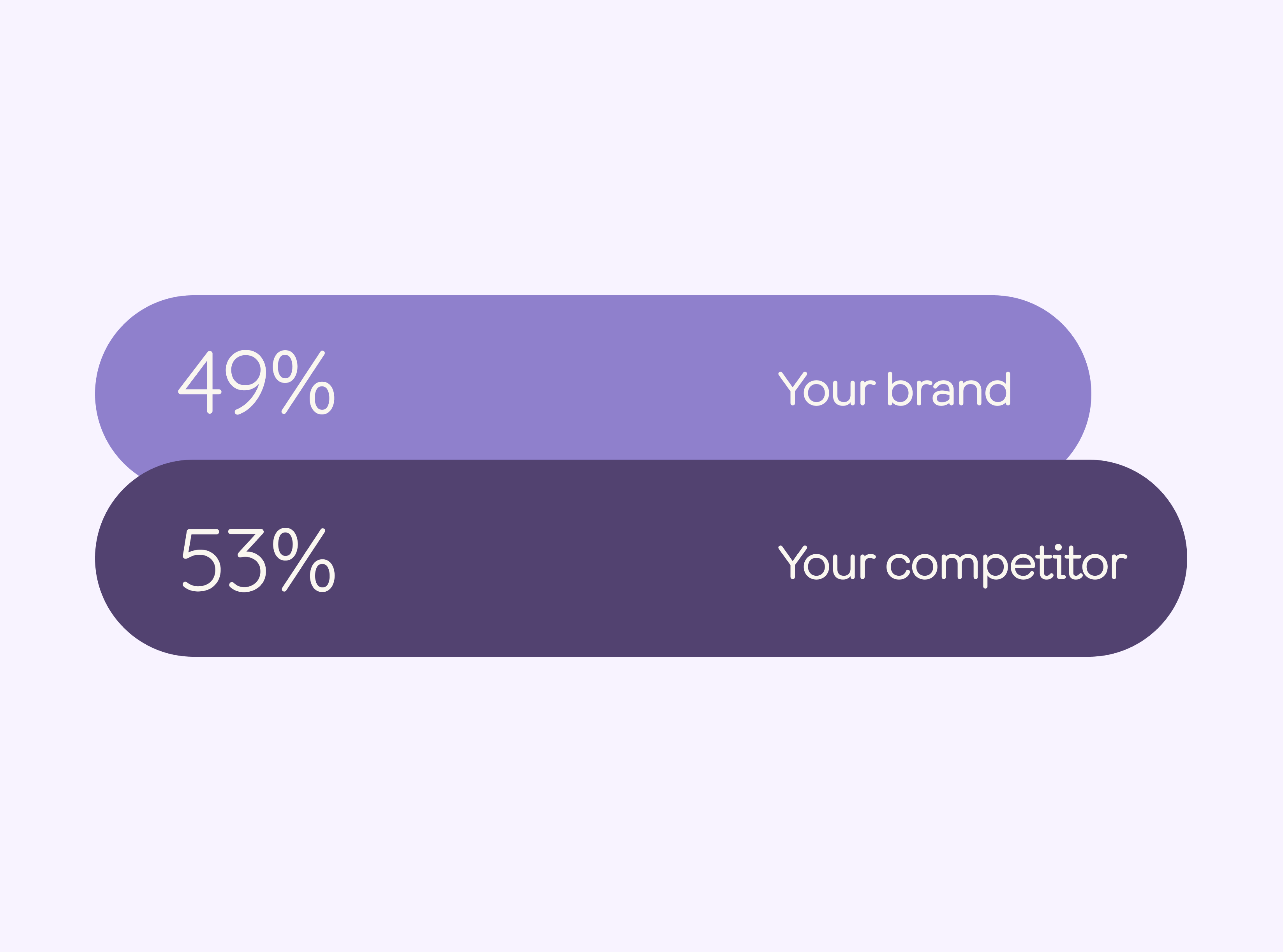
“Am I doing this right?” is a common question asked not only by emerging brands, but veterans within their industry.
It’s perfectly normal for brands to worry about how they ‘measure up’ against their competitors. But unless you take a data-driven approach to monitoring performance, you’re not going to gather any useful insights to help you build market share.
Regular competitor audits help you to keep your finger on the pulse of what‘s happening in your category, helping your brand stay relevant and appealing to your target audience. No matter whether you’re seeking marketing inspiration or refining your brand positioning, a competitor audit is one of the first steps towards better brand health
As they say, you’ve got to get your own house in order before comparing it to others. Alongside this article, you might want to check out our brand audit guide to get yours in tip top shape.
We’re going to dive into how brands can begin conducting audits by following Tracksuit’s very own competitor audit template. Let’s begin!
Sign up to Shorts
For fortnightly brand insights, stories and goodness that'll help you win (we promise).
Why conduct a competitor audit?
To understand what's working
Experimenting with different marketing approaches is essential to prevent your brand from becoming stale. But unless you can measure whether a certain strategy is building demand, how do you know if it’s worth keeping in your toolkit?
A competitor brand audit is an excellent way to review all the moving parts of your brand strategy and benchmark those results against your rivals.
To get ideas for your own brand
Creativity isn’t a bottomless well, and even the most seasoned marketing team can struggle for inspiration. One of the best ways to revive those dreaded brainstorming sessions? Undertaking an audit to review your competitor’s activities.
How competitors are speaking to your shared audience can spark fresh ideas for campaigns and branded content, helping you to build future demand more effectively.
To benchmark yourself against competitors
An in-depth competitor audit doesn’t just tell you what your rivals are up to; it also identifies what your audience enjoys engaging with - and who they want to engage with. If the results show that your brand isn’t their top choice, then it’s clear your team has some work to do to build trust and affinity with your intended customers.
How to Conduct a Competitor Audit
Step 1: Identify your top competitors
While there are likely already some competitors your brand is keeping a close eye on, there may be others that aren’t on your radar (yet).
Competitors can be divided into two groups: direct and indirect. A direct competitor refers to a business with a similar value proposition and target audience, while an indirect competitor has a similar target audience but a different value proposition, or vice versa. A strong competitor brand audit should involve a mix of direct and indirect competitors.
When it comes to choosing your competitor set to brand track with Tracksuit, you can select 5 other businesses. We recommend choosing 3 to 4 challenger brands that are your main competition and 1 to 2 incumbent brands that can be an aspirational target to aim for.
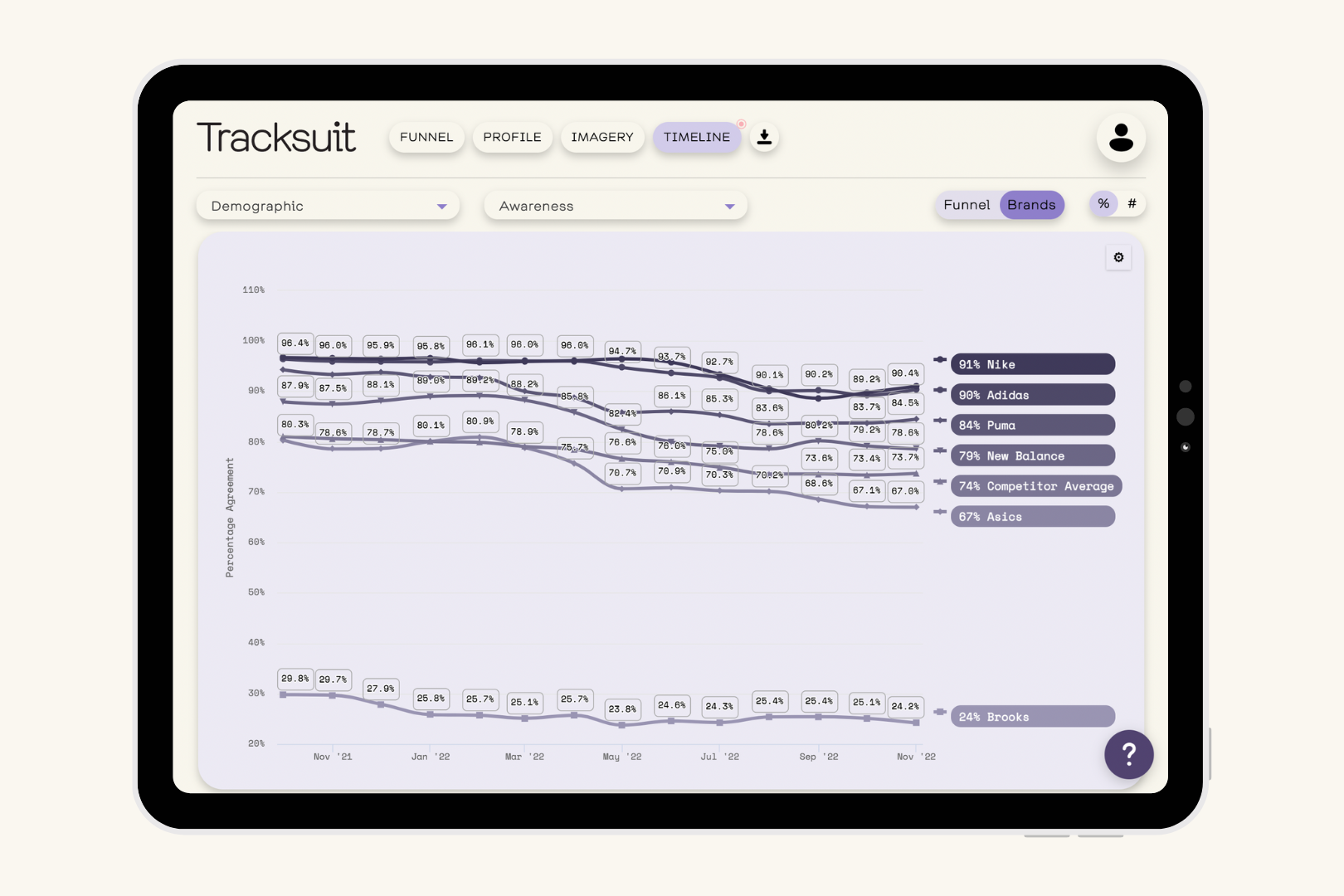
Step 2: Consider each competitor's general strengths and weaknesses
A competitor might be outperforming you in one area, but there could be another place where you have the upper hand. By analyzing their strengths and weaknesses as part of your competitor audit, you can form a picture of the ideal solution for your target audience.
Product demos, website analysis, case studies, and client testimonials are a few ways that brands can get a good sense of where competitors are doing well - and where they aren’t.
For example, if online reviews are consistently referencing difficulties with a competitor’s customer service team, this presents an opportunity to adjust your value proposition.
In the Imagery section of Tracksuit’s brand health dashboard, you can take a look at the various words associated with your brand in a side-by-side view with your competitors. This view provides a good indication of whether competitors are associating themselves with your key brand values. In other words, whether your competitors are better at being ‘you’ than you are.
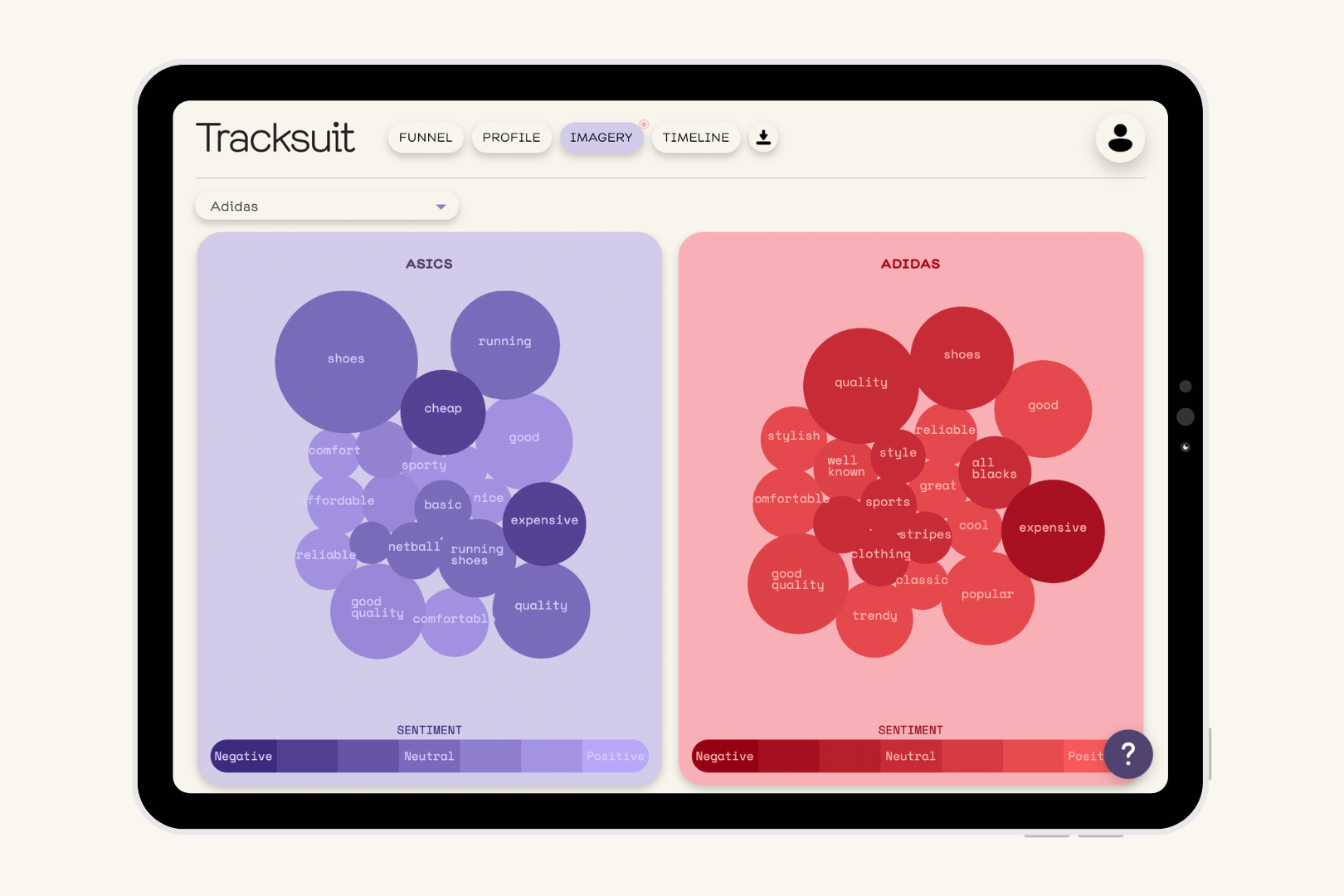
Step 3: Review competitors' content to see where your brand's gaps are
Ever heard the famous saying “keep your friends close and your enemies closer?” In addition to the Art of War, this applies to content analysis of your competitors.
To get a good understanding of where your competitors are the strongest performers, you need to follow their marketing efforts just as closely as their biggest fans:
Social Media
Auditing your competitor’s social media presence is an excellent way to understand how they are positioning their brand. Being able to see what resonates in your competitors’ social strategy helps you to differentiate your own approach and inspire fresh ideas.
Some things to pay attention to are:
- Weekly publishing volume
- Community engagement
- Post engagement
- Hashtag use
- Top monthly posts by engagement
- Recurring post themes
- Tone of Voice
- General content strengths
To make it easy, we’ve built this Competitor Social Media Analysis template, opens in new tab on Google Sheets, which you can use to conduct your own.
Google Ads
In the fight to secure consumers’ attention, Google Ads has become one of the key battlegrounds. So, how do you beat your competitors at their own game?
Type in your competitor’s name in Google, plus any important keywords they’re likely to be interested in. This will pull up any ads they’re currently running.
Take a look at a few features of their ads:
- Headline copy: The title copy used in ads, where up to 3 headlines will display for each ad
- Description copy: The longer-form copy that appears directly under the ad headlines.
- CTAs: What copy are they using to call you to action?
- Sitelink extensions: Additional links under the title ad URL directing you to more specific areas of the main site.
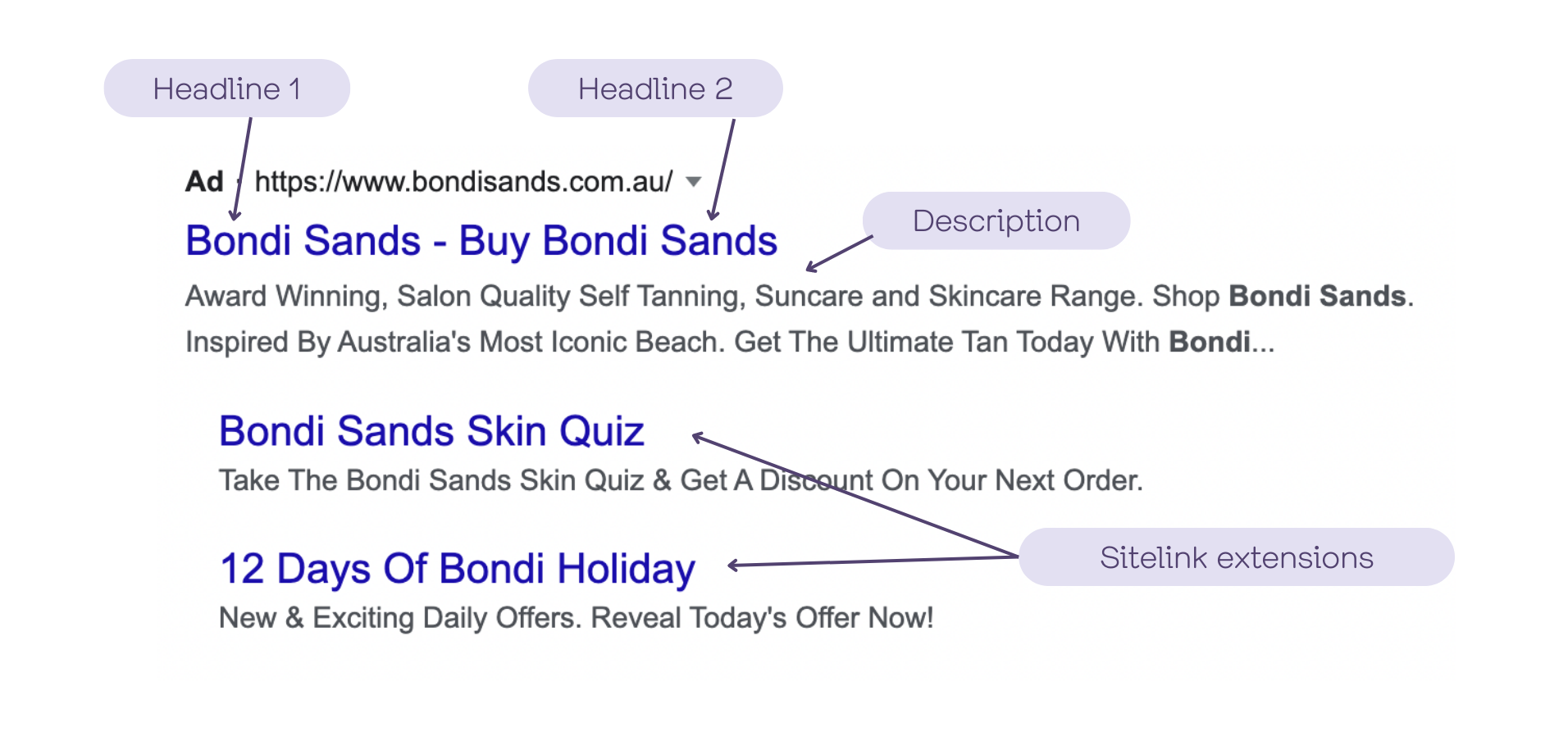
List what stands out as being compelling and persuasive for each competitor.
Checking out what search keywords your competitors are showing up for also gives you the option to bid on keywords that are important to your competitor’s ads strategy. This leads to opportunities for some rather cheeky ad copy, as shown below by Monday.com, who position themselves as the ‘best alternative’ to Airtable:
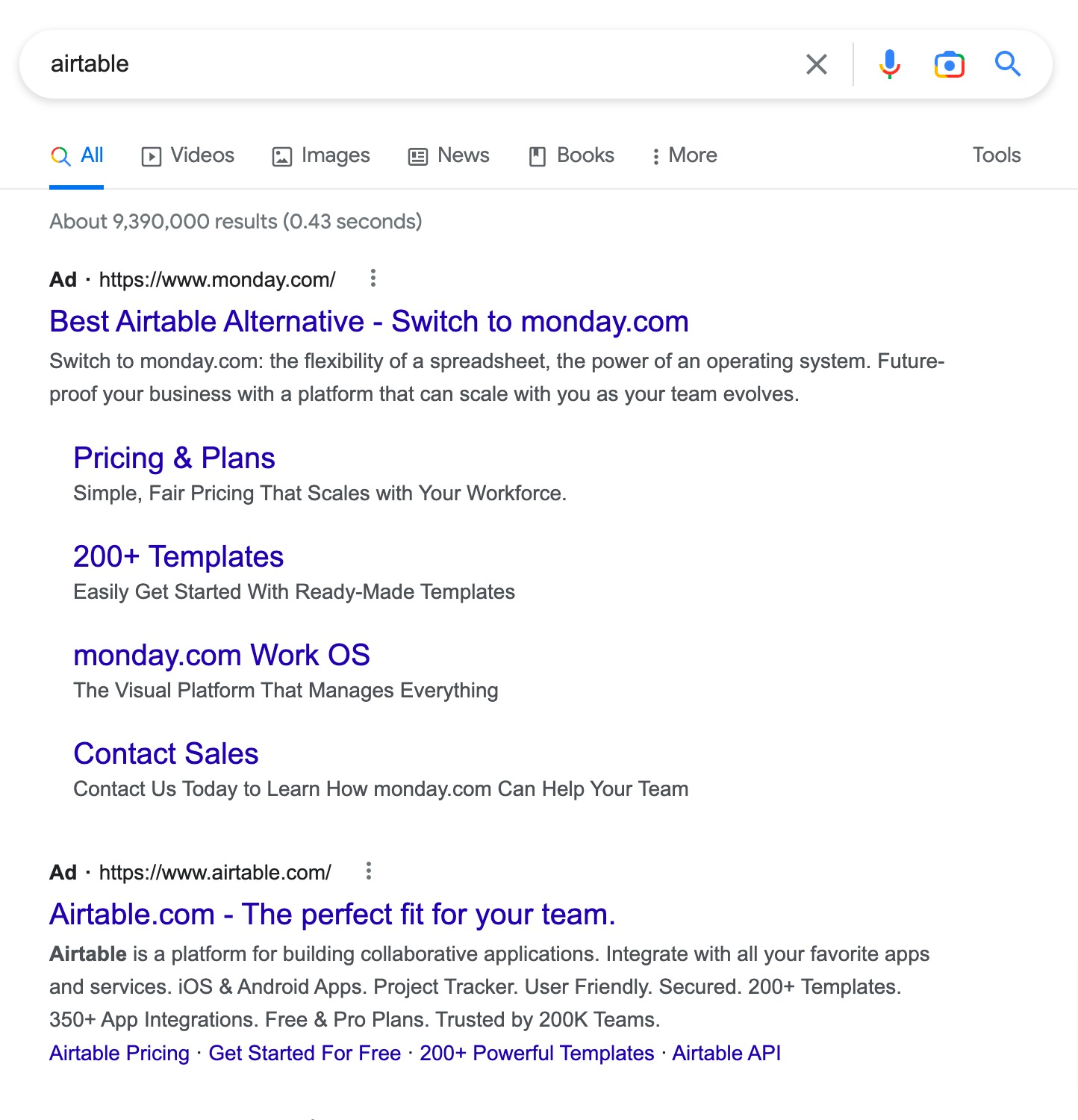

However, proceed with caution when bidding on competitors’ branded keywords, opens in new tab. The last thing you want to do when you’re small is ruffle the feathers of your more established competitors too much, leading them to retaliate with their far larger paid ads budget!
Pillar Content
Pillar content refers to any piece of in-depth, informative content, such as blogs, ebooks, and whitepapers. The purpose of pillar content is to assist brands in establishing authority and expertise over a topic that’s relevant to their offering.
For example, Hubspot dominates a range of topics related to marketing and CRM thanks to its ambitious pillar strategy. Their 2022 content marketing guide runs over 4,000 words, and also offers readers a free editorial calendar template and beginner guide to download:

Closely tracking your competitor’s pillar content allows you to identify lucrative content gaps that your brand can exploit to gain more visibility, both in Google search and via distribution channels like social media and email.
Bonus: Paid Ads
Like Google Ads, paid advertising on social media and the web is an increasingly important tool to counter shrinking organic reach across platforms - albeit one that’s much harder to track than Google. Tools such as AdSpy, opens in new tab and BigSpy, opens in new tab speed up this process by tracking social platforms on your behalf to find competitors’ ads and the level of engagement they’re receiving.
Step 4: Calculate your brand and your competitors' Share of Voice (SoV) and Share of Search (SoS)
Out of hundreds of measurements that brands can focus on in a competitor audit, Share of Voice (SoV) and Share of Search (SoS) are by far the most important.
Put simply, SoV and SoS are two different measures of brand visibility. Where SoV looks at brand mentions across paid advertising and media, SoS focuses on organic channels such as social media, website traffic, and email.
Together, SoV and SoS enable you to see how much brand awareness your business is building in comparison to your competitors. It brings together your activities across multiple channels to measure much of the conversation your brand is steering. And as we always say here at Tracksuit, what gets measured, gets managed
You can calculate SoV by dividing the number of brand mentions your company receives by the total number of competitor mentions. The bigger the share of the conversation your brand is driving, the more easily you can build market share.
SoS is a harder one to calculate, and there are various ways to do it (some involving paid SEO tools like Ahrefs). However, for the purpose of this audit, we consider share of search as the total number of times your brand is searched for, divided by the total number of searches for your key competitors.
You can find search volume information using trusty Google Trends, opens in new tab. Type your brand into the search bar over a chosen time frame (we recommend the previous year), note down the number, then repeat for your competitors’ brand names.
Share of Voice = number of brand mentions / total number of competitor mentions.
Share of Search = number of searches for your brand / total number of searches for your competitors.
BONUS STEP: See how your acquisition channels and website metrics stack up to your competitors
If you pop onto a site called SimilarWeb, opens in new tab, you can type your competitors name in the search bar and a whole bunch of interesting data will show up - most notably an estimate of top-line website analytics and a breakdown of traffic sources.
These metrics can give you a good idea of how your site stacks up to the other players in your field. Searching up established competition in your category can also provide aspirational metrics and insight on the size of your serviceable market.
Not too sure on the reliability of such estimated data? We took a look around the web and found that SimilarWeb is generally accepted as being pretty reliable. A freelancer who had access to a number of different business’ Google Analytics accounts ran some cross-comparison and found SimilarWeb provides mostly accurate metrics.
Step 5: Benchmark yourself against your competitors using a brand tracking software like Tracksuit
Turning the qualitative data of a competitor brand audit into actionable insights is more challenging than it might seem. You may have learned how many times a competitor posts on social media or what keywords they’re ranking for, but this doesn’t tell you how your target audience is responding to their efforts.
This is where an intelligent brand tracking solution like Tracksuit comes onto the field.
Consider it an affordable and always-on way to monitor your competitors and benchmark your performance (and, really, that’s just the beginning of what this all-in-one brand health dashboard does).
You choose 5 competitors to brand track across the five rungs of the customer journey that really matter: awareness, consideration, investigation, preference, and usage. Watch how your brand moves the dial on these metrics against your competitors in real time in Tracksuit’s timeline dashboard view.
While we advocate for the importance of conducting a qualitative competitor audit, as outlined above to inform your brand’s strategy, Tracksuit offers a hands-off, easy way to keep an eye on your competitors’ movements across the year.
It’s more insight for less work. We’re all about that here.

The finishing line 🏁
To sum it up, here are 4 points to keep in mind for your next competitor audit:
- What your competitors aren’t doing is just as important as what they are doing. While it can be tempting to copy your competitor’s branding and marketing approach, focusing on gaps in their content strategy or product offering allows your brand to build more unique selling points that set you up for long-term success.
- Pay attention to your indirect competitors, as well as your direct ones. Don’t be too quick to ignore companies who are offering a different solution to your own; if they’re targeting the same audience, they could take business away from your brand.
- Brand awareness will only get you so far. Brand awareness is an important aspect of any competitor audit. However, it’s not necessarily a reflection of market share. Your target audience could exhibit high levels of awareness and consideration for your brand, but ultimately opt to purchase from a competitor. If this is the case, something in your brand approach is preventing consumers from sealing the deal, and needs to be investigated.
- Metrics are only half of the story – you need to know what your audience thinks. Although KPIs like Share of Voice are helpful, they don’t tell you what your target customer associates with your brand or how likely they are to purchase from you. This is where an intelligence brand tracking platform like Tracksuit can make a world of difference.
Now it’s time to get out there, use this competitor audit template to check out your competitors’ moves, and start moving your own brand metrics the right way – up!


